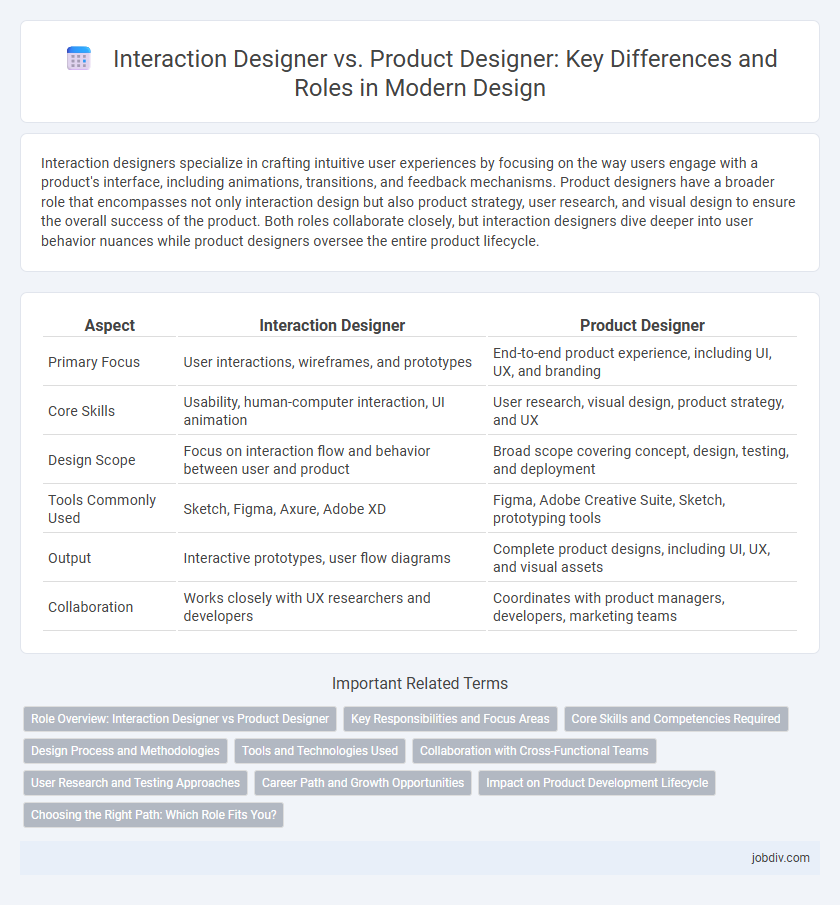Interaction designers specialize in crafting intuitive user experiences by focusing on the way users engage with a product's interface, including animations, transitions, and feedback mechanisms. Product designers have a broader role that encompasses not only interaction design but also product strategy, user research, and visual design to ensure the overall success of the product. Both roles collaborate closely, but interaction designers dive deeper into user behavior nuances while product designers oversee the entire product lifecycle.
Table of Comparison
| Aspect | Interaction Designer | Product Designer |
|---|---|---|
| Primary Focus | User interactions, wireframes, and prototypes | End-to-end product experience, including UI, UX, and branding |
| Core Skills | Usability, human-computer interaction, UI animation | User research, visual design, product strategy, and UX |
| Design Scope | Focus on interaction flow and behavior between user and product | Broad scope covering concept, design, testing, and deployment |
| Tools Commonly Used | Sketch, Figma, Axure, Adobe XD | Figma, Adobe Creative Suite, Sketch, prototyping tools |
| Output | Interactive prototypes, user flow diagrams | Complete product designs, including UI, UX, and visual assets |
| Collaboration | Works closely with UX researchers and developers | Coordinates with product managers, developers, marketing teams |
Role Overview: Interaction Designer vs Product Designer
Interaction Designers specialize in creating seamless user experiences by focusing on how users interact with a product's interface, emphasizing usability, wireframes, and prototyping. Product Designers encompass a broader scope, integrating user experience design, visual design, and product strategy to guide the development from concept to launch. Their role involves balancing user needs, business goals, and technical constraints to deliver holistic and market-ready solutions.
Key Responsibilities and Focus Areas
Interaction designers specialize in creating intuitive user interfaces, focusing on user behavior, engagement, and the flow of digital interactions to enhance usability and satisfaction. Product designers oversee the entire product lifecycle, integrating user experience with business goals, visual design, and technical feasibility to deliver a cohesive and market-ready solution. While interaction designers prioritize micro-level user interactions and prototyping, product designers balance strategic planning, user research, and cross-functional collaboration for end-to-end product development.
Core Skills and Competencies Required
Interaction Designers excel in user experience (UX) principles, wireframing, prototyping, and usability testing, emphasizing user interface (UI) design and seamless user flow. Product Designers combine UX/UI expertise with strategic thinking, product lifecycle knowledge, and cross-functional collaboration, ensuring the design aligns with business goals and market needs. Both roles require proficiency in design tools like Figma, Sketch, and Adobe XD, strong problem-solving skills, and an understanding of user-centered design methodologies.
Design Process and Methodologies
Interaction Designers prioritize user interface and usability through wireframing, prototyping, and user testing, emphasizing user-centered design methodologies like heuristic evaluation and cognitive walkthroughs. Product Designers adopt a broader design process, integrating market research, product strategy, and cross-functional collaboration while employing agile and design thinking frameworks to iterate on both form and function. Both roles utilize user journey mapping and persona development but differ in scope and application within the product lifecycle.
Tools and Technologies Used
Interaction designers primarily utilize wireframing and prototyping tools such as Sketch, Figma, and Adobe XD to create user flow and interactive elements. Product designers complement these by integrating user research tools like UserTesting and analytics platforms such as Google Analytics to inform design decisions and track product performance. Both roles leverage collaborative technologies including Zeplin and InVision to streamline the handoff between design and development teams.
Collaboration with Cross-Functional Teams
Interaction designers specialize in creating seamless user experiences through detailed interface design, working closely with developers and marketers to ensure functionality and engagement. Product designers take a broader approach, collaborating with engineers, data analysts, and business stakeholders to align design strategy with product goals and user needs. Both roles require strong teamwork across cross-functional teams to deliver cohesive, user-centered digital products.
User Research and Testing Approaches
Interaction Designers prioritize user research methods such as contextual inquiry and usability testing to optimize interface behaviors and micro-interactions. Product Designers employ broader user research techniques including ethnographic studies and A/B testing, integrating findings to refine overall product functionality and user experience. Both roles emphasize iterative testing but differ in scope, with Interaction Designers honing in on specific interaction patterns and Product Designers addressing comprehensive user needs and business goals.
Career Path and Growth Opportunities
Interaction Designers specialize in creating intuitive user experiences by focusing on the behavior and flow of digital products, often starting their careers with roles in UX research or interface design. Product Designers take a broader approach, overseeing the entire product lifecycle from concept to launch, integrating UX, UI, and business strategy, which allows for growth into product management or leadership positions. Career progression for Interaction Designers often leads to UX leadership roles, while Product Designers can advance to senior product strategist or design director roles, reflecting their cross-functional expertise.
Impact on Product Development Lifecycle
Interaction Designers specialize in defining user behaviors and crafting intuitive interfaces, directly shaping the usability phase of the product development lifecycle. Product Designers oversee the end-to-end process, integrating user research, interaction design, and business objectives to influence concept creation, iteration, and launch. Their collaborative impact ensures a cohesive product that balances functionality, aesthetics, and user experience throughout development.
Choosing the Right Path: Which Role Fits You?
Interaction designers specialize in crafting intuitive user interfaces and seamless experiences, focusing on how users interact with digital products. Product designers adopt a broader role, integrating user experience, business goals, and technical feasibility to shape the entire product lifecycle. Assess your strengths in user research, prototyping, and strategic thinking to determine whether a focused interaction design or a holistic product design path aligns best with your career aspirations.
Interaction Designer vs Product Designer Infographic

 jobdiv.com
jobdiv.com